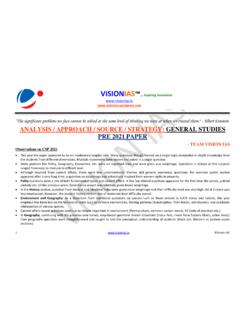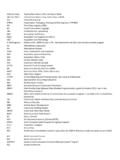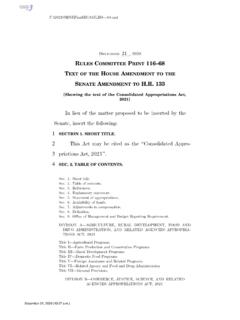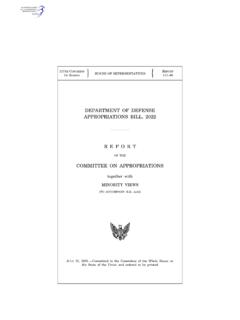Transcription of M3 65S
1 Nrty3 56 MSAIN 1 DELHI | PUNE | HYDERABAD | AHMEDABAD | JAIPUR | LUCKNOW | CHANDIGARH | GUWAHATI 8468022022 SECURITY Table of Contents 1. DEFENCE _____ 3 Indigenisation of Defence Industry ____ 3 Defence Acquisition Procedure, 2020 ___ 4 Defence procurement Reforms _____ 5 Defense Modernization _____ 6 Integrated Theatre Commands _____ 8 2. BORDER SECURITY AND MANAGEMENT 10 Role of Technology in Border Management _____ 11 Maritime Security _____ 13 Piracy in the Indian Ocean Region _____ 16 3. TERRORISM _____ 19 Unlawful Activities [Prevention] Act __ 20 Financial Action Task Force _____ 21 Bio-Terrorism _____ 22 Naxal Violence _____ 24 Overground Workers (OGWs) _____ 27 4. POLICE REFORMS _____ 29 5. CYBERSECURITY _____ 30 Critical Infrastructure _____ 31 National Security Directive on the Telecom Sector _____ 33 Cyber-nuclear security architecture ____ 34 Cyber Surveillance _____ 35 Facial Recognition Technology _____ 36 6.
2 INSURGENCY IN THE NORTH EAST ____ 39 Bodo Peace Accord _____ 41 7. MISCELLANEOUS _____ 43 Intelligence Reforms _____ 43 Internet Shutdowns _____ 45 Drone Regulations in India _____ 45 2 8468022022 DELHI | PUNE | HYDERABAD | AHMEDABAD | JAIPUR | LUCKNOW | CHANDIGARH | GUWAHATI 3 DELHI | PUNE | HYDERABAD | AHMEDABAD | JAIPUR | LUCKNOW | CHANDIGARH | GUWAHATI 8468022022 1. DEFENCE INDIGENISATION OF DEFENCE INDUSTRY Why in news? With a series of measures to boost domestic defence industry, India was featured in the Stockholm International Peace Research Institute (SIPRI s) arms exporters list for the first time. 4 8468022022 DELHI | PUNE | HYDERABAD | AHMEDABAD | JAIPUR | LUCKNOW | CHANDIGARH | GUWAHATI 1. 1. 1. DEFE NCE ACQUI SITION PROCEDURE, 202 0 Why in News? Recently Defence Ministry unveiled Defence Acquisition Procedure, 2020 (erstwhile Defence procurement Procedure (DPP)) which will supersede DPP 2016.
3 Salient features of policy To promote Indigenisation of Imported Spares: o List of Weapons/Platforms for Import Ban to promote domestic and indigenous industry. o New Category of Buy (Global Manufacture in India) has been incorporated in line with new FDI policy and to encourage foreign original equipment manufacturers (OEMs) to setup manufacturing or maintenance entities through its subsidiary in India while enabling requisite protections to domestic industry. Recently there was enhancement of FDI through automatic route from 49% to 74% in defence. o Request For Information(RFI) to explore willingness of the prospective foreign vendors to setup an indigenous eco system at the spares/sub component level. o Reservation in Categories for Indian Vendors: The categories of Buy(Indian-IDDM), Make I, Make II, Production Agency in Design &Development, Ordinace Factory Board/DPSU and SP model will be exclusively reserved for Indian Vendors meeting the criteria of Ownership and Control by resident Indian Citizens with FDI not more than 49%.
4 O Other proposed measures such as after sales support part of capital acquisition contract, higher indigenous content in acquisitions and incentives for local material and software and emphasis on product export under offsets. For Time Bound Defence procurement process , Faster Decision Making and Ease of Doing Business: o Revision in Offset policy : Offset policy clause (as there in the DPP 2002) for offsets for inter-government agreement (IGA), government-to-government defence deals and single-vendor contracts for the procurement of arms has been removed. Under the offset policy , the foreign defence entities were mandated to spend at least 30% of the total contract value in India through procurement of components, transfer of technologies or setting up of research and development facilities. o Setting up of project management unit (PMU) that will facilitate obtaining advisory and consultancy support in specified areas to streamline the acquisition process and support contract management.
5 O Simplification of Trial Procedures to nurture competition. o Single stage accord of AoN (Acceptance of Necessity) in all cases up to 500 crore to avoid delays in approval of acquisition proposals. Leasing: It has been introduced as a new category for acquisition in addition to the existing Buy and Make categories to substitute huge initial capital outlays with periodical rental payments. Significance of the policy DAP is aligned with the vision of the government's 'Aatmanirbhar Bharat' to make India a global defense manufacturing hub. Reduce dependence on imports: India is one of the largest importers of conventional defence equipment spending about 30% of its total defence budget on capital acquisitions. Boost overall economy: Government aims for a turnover of lakh crore in defence manufacturing by 2025. Ensure timely acquisition of military equipment, systems and platforms as required by the Armed Forces To modernise and improve capabilities of the Armed Forces by providing impetus to indigenisation and technology infusion.
6 Defined role for Private sector: Private investment will be a major contributor to the Make in India initiative, accelerate manufacturing-led industrial growth and for capital and technology advancement. 5 DELHI | PUNE | HYDERABAD | AHMEDABAD | JAIPUR | LUCKNOW | CHANDIGARH | GUWAHATI 8468022022 o This will be useful for military equipment not used in actual warfare like transport fleets, trainers, simulators, among others. Strategic Partnership Model (SPM): Acquisitions under the SPM refer to participation of private Indian firms along with foreign OEM in Make in India in defense and play the role of a System Integrator by building an extensive eco-system comprising development partners, specialised vendors and suppliers, in particular, those from the MSME sector. o Strategic Partnerships will seek to enhance indigenous defence manufacturing capabilities through the private sector over and above the existing production base.
7 1.. DEFE NCE PROC UREMENT REFORMS Why in News? The Ministry of Defence approved Delegation of Financial Powers to Defence Services (DFPDS) 2021 order, notifying enhanced delegation of Revenue procurement powers to the Armed Forces. More on News Aimed to strengthen security infrastructure of the country through greater decentralization, it covers Schedules of Powers for Army, Navy, Air Force, and Integrated Defence Staff. The new guidelines devolve greater financial powers to field formations (5-10 times), Competent Financial Authorities (2 times), Vice Chiefs of Services (by 10%, subject to Rs 500 crore) etc. This includes up to three times increase in Schedules related to Indigenization/R&D to achieve Atma Nirbhar Bharat . Benefits for Armed Forces: Streamlining of the procurement process for optimum utilization of resources; Meeting immediate necessities for better planning and operational preparedness; Quick decision making at all levels; and Greater integration among Services.
8 Status of Defence Procurements by India Expenditure: India is the third largest military spender of world, after USA and China, with a defence budget of about US$ 73 billion. Distribution of expenditure: Out of total expenditure, about 1/3rd is allocated for capital outlay which includes the defence procurement , , the acquisition of defence equipment, systems, and platforms. o Of the defence procurement share, almost half of the amount is spent on purchases from foreign suppliers, making India the 2nd biggest importer of weapons after Saudi Arabia (SIPRI Fact Sheet on Trends in International Arms Transfers, 2020 ). Despite large spending on foreign procurement , India s Defence Preparedness with regard to arms and ammunition and key defence systems like aircraft carriers and fighter jets remains sub-optimal. What are the issues in Indian Defence procurement ecosystem?
9 Inordinate procedural delays: The delay between projection of requirement by armed forces and actual delivery is quite high. , the Submarine Project P-75I has reached only to Request for Proposal stage in 2021 despite being in pipeline for greater part of last two decades. Coordination Issues: Due to large number of stakeholders involved, the problem of coordination adds to the delay. For example, communication gaps between army and the Ministry of Defence. Lack of Consistency: Frequent changes in policy and specifications also cause delay or scrapping of projects. , despite shortages and ageing assets, the old tenders issued through old policy are scrapped on adoption of a new policy . Presence of corruption and middlemen: Allegations of corruption and involvement of middlemen/vested interests are common in Indian defence procurements. Political will: Despite unsettled conflicts along borders, indecisive political decisions over foreign procurement has left armed forces severely ill-equipped.
10 Lack of strategic vision on long-term defence needs in public domain, discouraging investments from foreign and domestic defence manufacturing. Why large share of imports? As per Estimates Committee (2018), high dependence of armed forces on imports is due to- Slow rate of indigenization. Limited indigenous capabilities, especially on large and high-technology weapons/equipment necessary for modernization of defence forces. Limited private sector participation. 6 8468022022 DELHI | PUNE | HYDERABAD | AHMEDABAD | JAIPUR | LUCKNOW | CHANDIGARH | GUWAHATI The problems of procurement are accompanied by structural issues such as limited indigenization of the armed forces, limited and strained budgets among others. Steps taken to streamline overall Defence procurement System While DFPDS provides for operational efficiency, steps are also taken to create a robust procurement system.

















